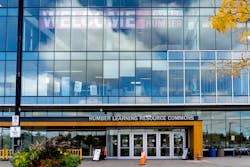In partnership with Siemens Canada, Humber College Institute of Technology & Advanced Learning Innovation is developing a Sustainable Microgrid and Renewable Technology (SMART) lab that will include Smartflower solar technology.
The SMART lab, which will be located at Humber’s north campus in Toronto, Canada, will feature a microgrid monitoring and controller system, a battery energy storage system and distribution infrastructure. Electric vehicle charging stations and battery energy storage systems will be used to generate and distribute energy locally, as will the Smartflower technology.
The Smartflower has solar panels that open like petals and track the sun as it moves across the sky, allowing it to generate 40% more electricity than is possible with a stationary panel. Essentially a small-scale power grid itself, the Smartflower can operate independently or as part of a larger grid.
Educational opportunities
Humber expects the SMART lab will help fill the skills gap for in-demand jobs of the future.
A living laboratory, Humber’s students will get hands-on experience that will give them the knowledge and skills necessary to design, operate and maintain microgrids.
“Working with Siemens will enable us to train the next generation of professionals in the field of green technology, and the SMART lab will bring Humber another step closer to achieving its own sustainability goals,” said Ann Marie Vaughan, president and CEO of Humber College.
Humber plans to offer credentials in the fields of microgrids and renewable energy. It is also creating new curriculum in its Electrical and Computer Engineering and Sustainable Energy and Building Technology programs.
“It is essential that postsecondary institutions have the latest learning tools and equipment so students can develop the skills they need to succeed in the workforce,” said Jill Dunlop, Ontario minister of colleges and universities.
Research opportunities
The SMART lab will also include generation and load simulation equipment that can be used for applied research projects with industry partners. Humber will offer research and training opportunities to industry stakeholders, including utilities, technology companies, local governments and community planners.
Facilities like Humber’s SMART lab will be vital to the energy economy, according to Faisal Kazi, president and CEO of Siemens Canada. “An effective energy transition to enable decarbonization is a complex effort, and it requires a growing system of partners to tackle this enormous challenge,” he said.
Dunlop said, “It is projects like this that help find sustainable solutions within industries, prepare students for the workforce, and help drive our economy forward.”
Advancing microgrid technology through living labs
The Humber SMART lab is not the first college microgrid collaboration for Siemens. In 2017, the company partnered with Santa Fe Community College in New Mexico to build the Building Energy Automation and Microgrid Training Center (BEAMTC).
Like the SMART lab, the BEAMTC is focused on workforce training, testing and innovation.
Siemens also has a demonstration microgrid, or living lab, at its US technology headquarters in Princeton, New Jersey. Siemens recently announced the launch of an interactive virtual environment that gives the public, customers and partners the opportunity to tour the microgrid system from anywhere in the world. The tour includes a demonstration of the system’s microgrid dashboard.








